engine MAZDA PROTEGE 1992 Workshop Manual
[x] Cancel search | Manufacturer: MAZDA, Model Year: 1992, Model line: PROTEGE, Model: MAZDA PROTEGE 1992Pages: 1164, PDF Size: 81.9 MB
Page 1 of 1164
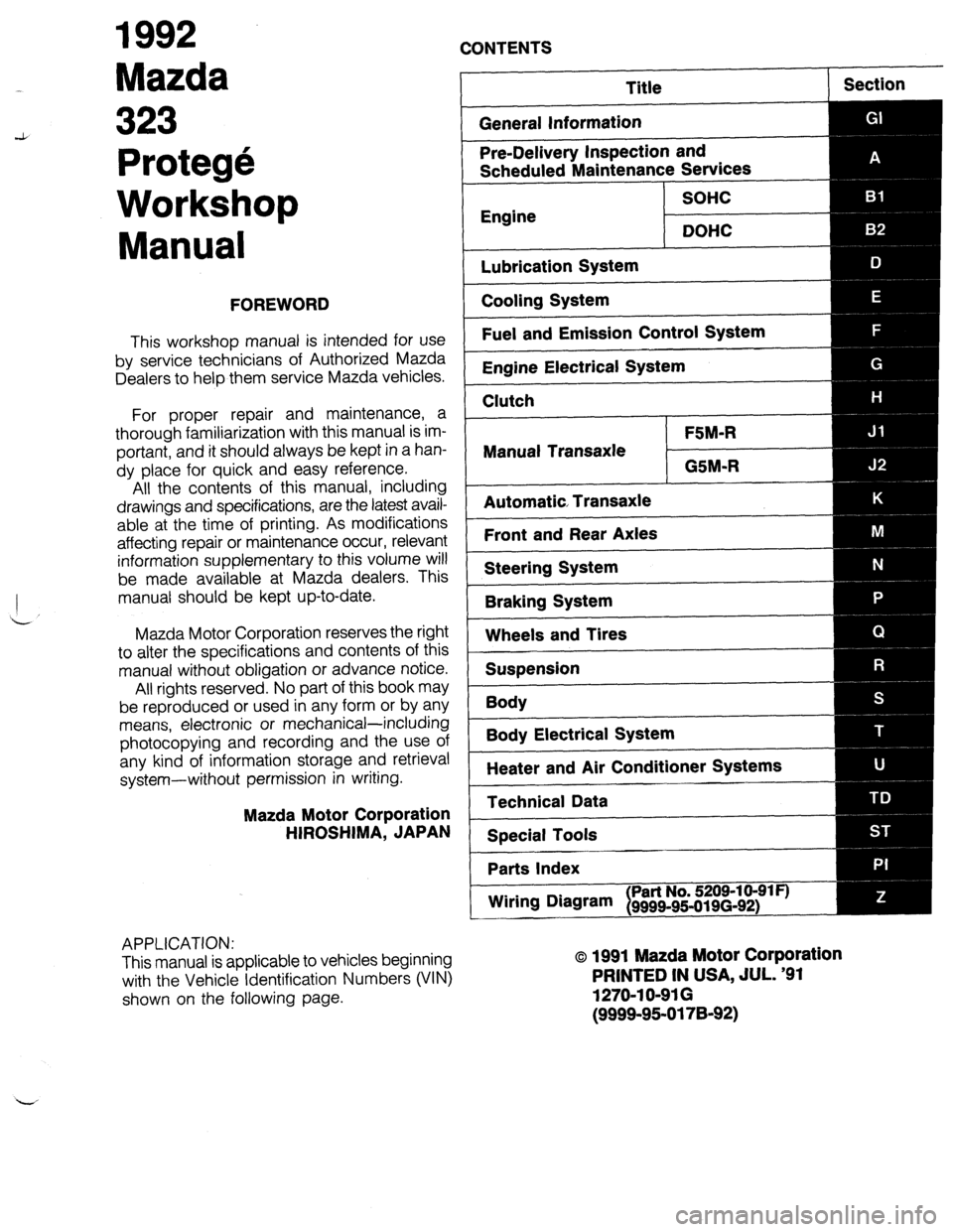
1992
Mazda
CONTENTS
Protege
Workshop
Manual
FOREWORD
This workshop manual is intended for use
by service technicians of Authorized Mazda
Dealers to help them service Mazda vehicles.
For proper repair and maintenance, a
thorough familiarization with this manual is im-
portant, and it should always be kept in a han-
dy place for quick and easy reference.
All the contents of this manual, including
drawings and specifications, are the latest avail-
able at the time of printing. As modifications
affecting repair or maintenance occur, relevant
information supplementary to this volume will
be made available at Mazda dealers. This
manual should be kept up-to-date.
Mazda Motor Corporation reserves the right
to alter the specifications and contents of this
manual without obligation or advance notice.
All rights reserved. No part of this book may
be reproduced or used in any form or by any
means, electronic or mechanical-including
photocopying and recording and the use of
any kind of information storage and retrieval
system-without permission in writing.
Mazda Motor Corporation
HIROSHIMA, JAPAN
APPLICATION:
This manual is applicable to vehicles beginning
with the Vehicle Identification Numbers (VIN)
shown on the following page.
Title
General Information Section
Pre-Delivery Inspection and
Scheduled Maintenance Services
SOHC
Engine
DOHC
Lubrication System
Cooling System
Fuel and Emission Control System
Engine Electrical System
Clutch
FSM-R
Manual Transaxle
GSM-R
Automatic Transaxle
Front and Rear Axles
Steering System
Braking System
Wheels and Tires
Suspension
Body
--
Body Electrical System
Heater and Air Conditioner Systems
Technical Data
Special Tools
Parts Index
Wiring DNvam
I Part No. 5209-10-91 F)
9999~95-019(3-92)
o 1991 Mazda Motor Corporation
PRINTED IN USA, JUL. ‘91
1270-l O-91 G
(9999-95-0178-92)
Page 4 of 1164
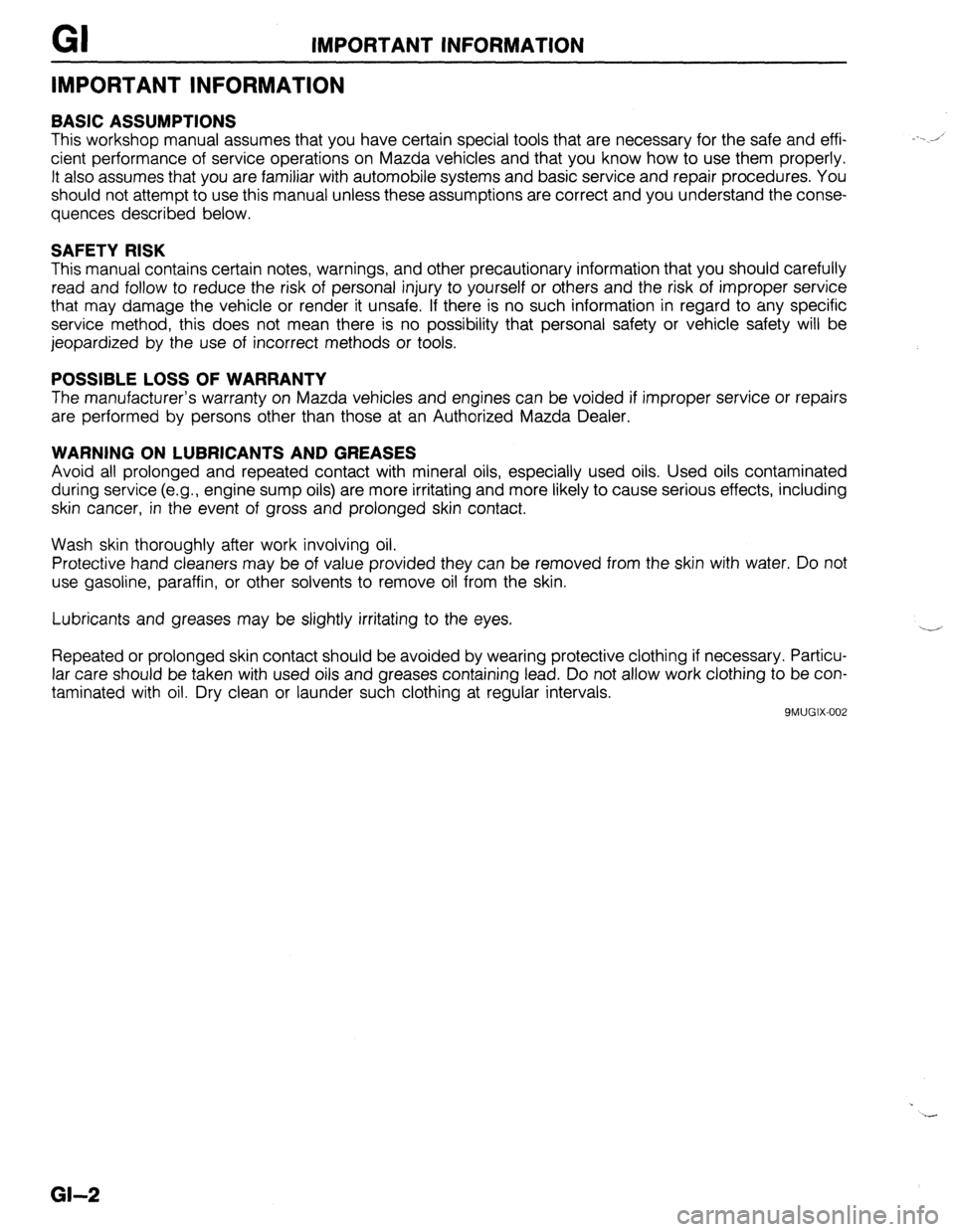
IMPORTANT INFORMATION
IMPORTANT INFORMATION
BASIC ASSUMPTIONS
This workshop manual assumes that you have certain special tools that are necessary for the safe and effi-
cient performance of service operations on Mazda vehicles and that you know how to use them properly.
It also assumes that you are familiar with automobile systems and basic service and repair procedures. You
should not attempt to use this manual unless these assumptions are correct and you understand the conse-
quences described below.
SAFETY RISK
This manual contains certain notes, warnings, and other precautionary information that you should carefully
read and follow to reduce the risk of personal injury to yourself or others and the risk of improper service
that may damage the vehicle or render it unsafe. If there is no such information in regard to any specific
service method, this does not mean there is no possibility that personal safety or vehicle safety will be
jeopardized by the use of incorrect methods or tools.
POSSIBLE LOSS OF WARRANTY
The manufacturer’s warranty on Mazda vehicles and engines can be voided if improper service or repairs
are performed by persons other than those at an Authorized Mazda Dealer.
WARNING ON LUBRICANTS AND GREASES
Avoid all prolonged and repeated contact with mineral oils, especially used oils. Used oils contaminated
during service (e.g., engine sump oils) are more irritating and more likely to cause serious effects, including
skin cancer, in the event of gross and prolonged skin contact.
Wash skin thoroughly after work involving oil.
Protective hand cleaners may be of value provided they can be removed from the skin with water. Do not
use gasoline, paraffin, or other solvents to remove oil from the skin.
Lubricants and greases may be slightly irritating to the eyes.
Repeated or prolonged skin contact should be avoided by wearing protective clothing if necessary. Particu-
lar care should be taken with used oils and greases containing lead. Do not allow work clothing to be con-
taminated with oil. Dry clean or launder such clothing at regular intervals.
9MUGIX-002
GI-2
Page 6 of 1164
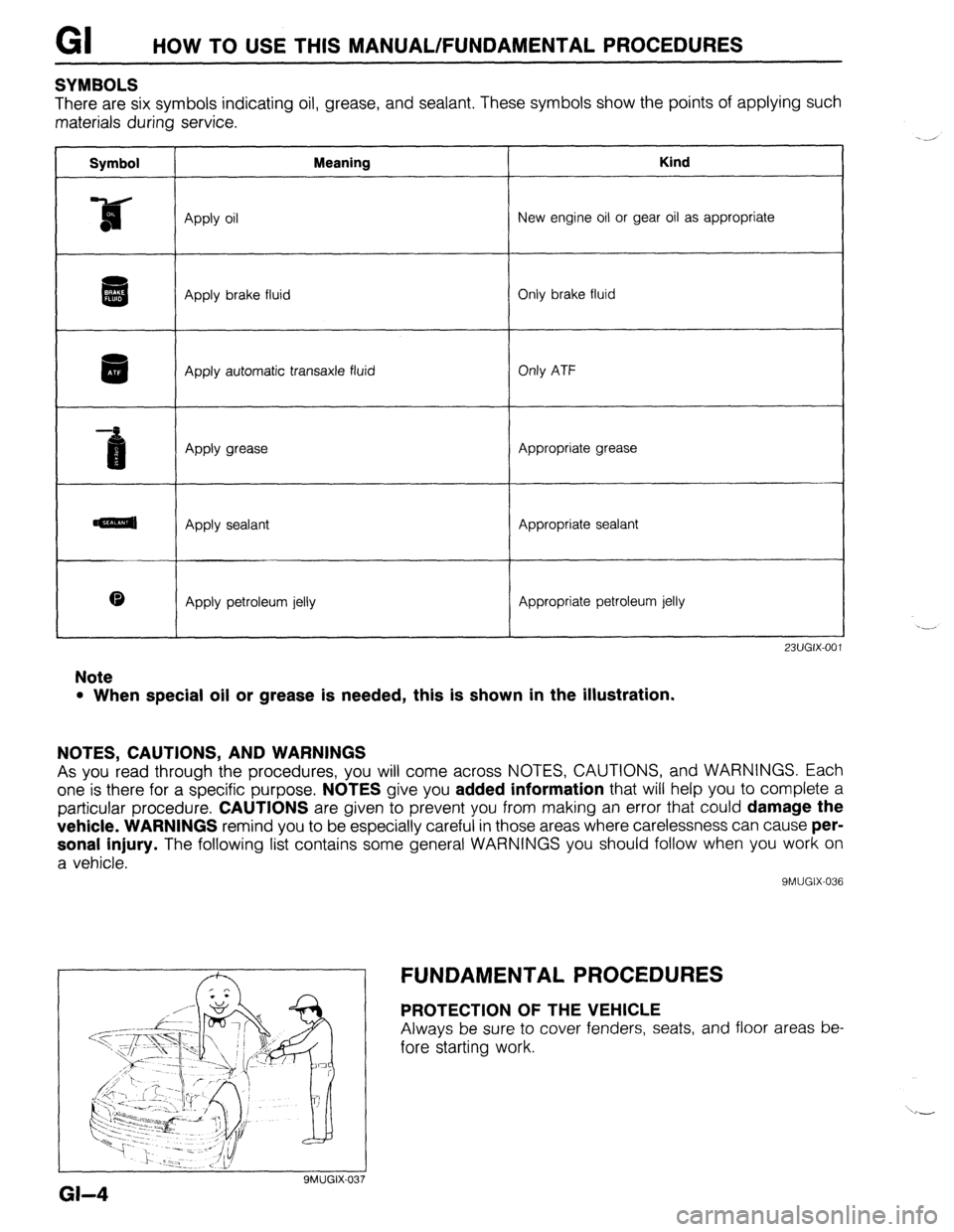
HOW TO USE THIS MANUAL/FUNDAMENTAL PROCEDURES
SYMBOLS
There are six symbols indicating oil, grease, and sealant. These symbols show the points of applying such
materials during service.
Symbol Meaning Kind
Apply oil New engine oil or gear oil as appropriate
aI i . Apply brake fluid Only brake fluid
Apply automatic transaxle fluid Only ATF
Apply grease Appropriate grease
amal Apply sealant Appropriate sealant
0 Apply petroleum jelly Appropriate petroleum jelly
23UGIX-001
Note
l When special oil or grease is needed, this is shown in the illustration.
NOTES, CAUTIONS, AND WARNINGS
As you read through the procedures, you will come across NOTES, CAUTIONS, and WARNINGS. Each
one is there for a specific purpose.
NOTES give you added information that will help you to complete a
particular procedure.
CAUTIONS are given to prevent you from making an error that could damage the
vehicle. WARNINGS
remind you to be especially careful in those areas where carelessness can cause per-
sonal injury.
The following list contains some general WARNINGS you should follow when you work on
a vehicle.
9MUGIX-036
SMUGIX-037
a-4 FUNDAMENTAL PROCEDURES
PROTECTION OF THE VEHICLE
Always be sure to cover fenders, seats, and floor areas be-
fore starting work.
Page 7 of 1164
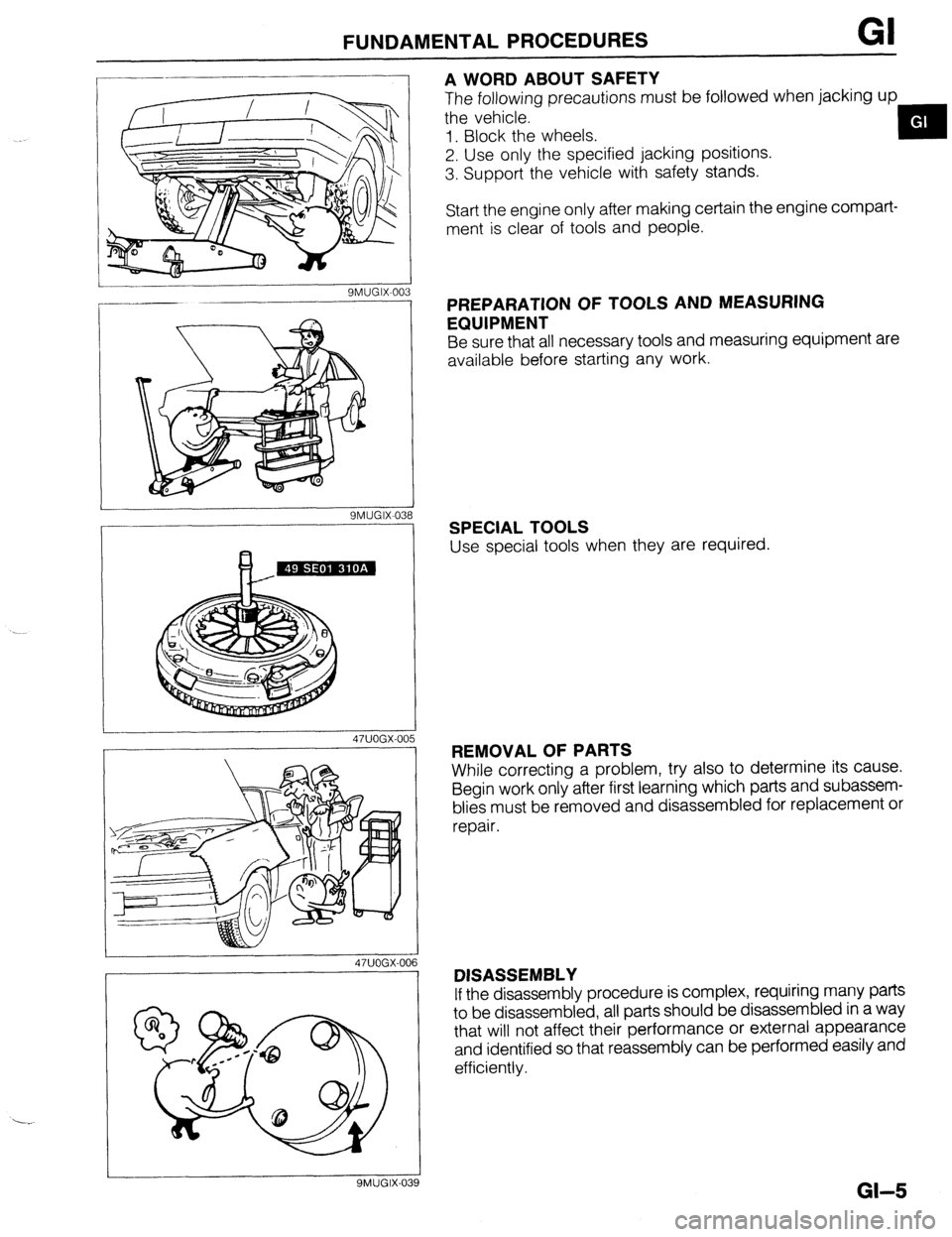
FUNDAMENTALPROCEDURES GI
SMUGIX-0: B
47UOGX-00 5 ‘3
16
A WORD ABOUT SAFETY
The following precautions must be followed when jacking up
the vehicle.
1. Block the wheels.
2. Use only the specified jacking positions.
3. Support the vehicle with safety stands.
Start the engine only after making certain the engine compart-
ment is clear of tools and people.
PREPARATION OF TOOLS AND MEASURING
EQUIPMENT
Be sure that all necessary tools and measuring equipment are
available before starting any work.
SPECIAL TOOLS
Use special tools when they are required.
REMOVAL OF PARTS
While correcting a problem, try also to determine its cause.
Begin work only after first learning which parts and subassem-
blies must be removed and disassembled for replacement or
repair.
DISASSEMBLY
If the disassembly procedure is complex, requiring many parts
to be disassembled, all parts should be disassembled in a way
that will not affect their performance or external appearance
and identified so that reassembly can be performed easily and
efficiently.
GI-5
Page 12 of 1164

GI IDENTIFICATION NUMBER LOCATIONS/UNITS/ABBREVlATlONS
VEHICLE IDENTIFICATION NUMBER (VIN) AUTOMATIC TRANSAXLE MODEL AND NUMBER
ENGINE MODEL AND NUMBER
B6 ENGINE
IDENTIFICATION NUMBER LOCATIONS
UNITS
I
N.m (m-kg or cm-kg,
ft-lb or in-lb) . . . . . . . . . . . . . . . . . . Torque
rpm ._..,,,.............,.......... Revolutions per minute
A . . . . . . . . . . . . . . . . . Ampere(s)
v, . . . . . . . . . . . . . .
Volt(s)
$2 _....._..,......................... Ohm(s) (resistance)
kPa (kg/cm2,
psi) . . . . . . . . . . Pressure
(usually positive)
mmHg (inHg) . . . . . . . . . . . . . . . Pressure
(usually negative)
W.. . . . . . . . . . . .
Watt
liters (US qt, Imp qt) ,... Volume
mm (in) ..,......,...,........... Length
89UOGX-00
ABBREVIATIONS
ABDC . . . . . . . . . . . . . . . . . . . . .
After bottom dead
center
A/C . . . . . . . . . . . . . . . . . . . . . . . . . . . . . . .
Air conditioner
ACC ..,.,...... 3 . . . . . . . . . . . . . . . . . Accessories
ATX . . . . . . . . . . . . . . . . . . . . . . . . . . . . . . Automatic transaxle
ATDC ..,,...,...,............... After top dead center
ATF . . . . . . . . . . . . . . . . . Automatic transaxle
fluid
BBDC ,,..,.......,...,......,... Before bottom dead
center
BTDC .,......,...............,.. Before top dead center
CPU ..,,.......,...,..........,.. Central processing unit
DOHC ..,...,..,............,,.. Double overhead
camshaft
DRL ____.......................... Daytime running lights
EC-AT .,_.......,............,,.. Electronically-controlled
automatic transaxle
L
GI-10
ECU ............................. Engine control unit
EGI ............................... Electronic gasoline
injection
E/L.. .............................. Electrical load
EX ................................ Exhaust
GND.. ........................... Ground
HLA.. ............................ Hydraulic lash adjuster
IGN ............................... Ignition
IN ................................. Intake
INT ............................... Intermittent
ISC
............................... idle speed control
LH ................................ Left hand
M..
................................ Motor
MIL..
............................. Malfunction indicator
lamp
M/S..
............................. Manual steering
MTX.. ............................ Manual transaxle
OD ................................ Overdrive
OFF.. ............................ Switch off
ON.. .............................. Switch on
PCV.. ............................ Positive crankcase
ventilation
PRC..
............................ Pressure regulator
control
PIS ................................ Power steering
RH..
.............................. Right hand
SOHC.. .........................
z;;kiprhead
SST ............................... Special service tool
SW.. .............................. Switch
TNS
.............................. Tail number side
VICS
............................. Variable inertia charging
system
23UGIX-00
Page 13 of 1164
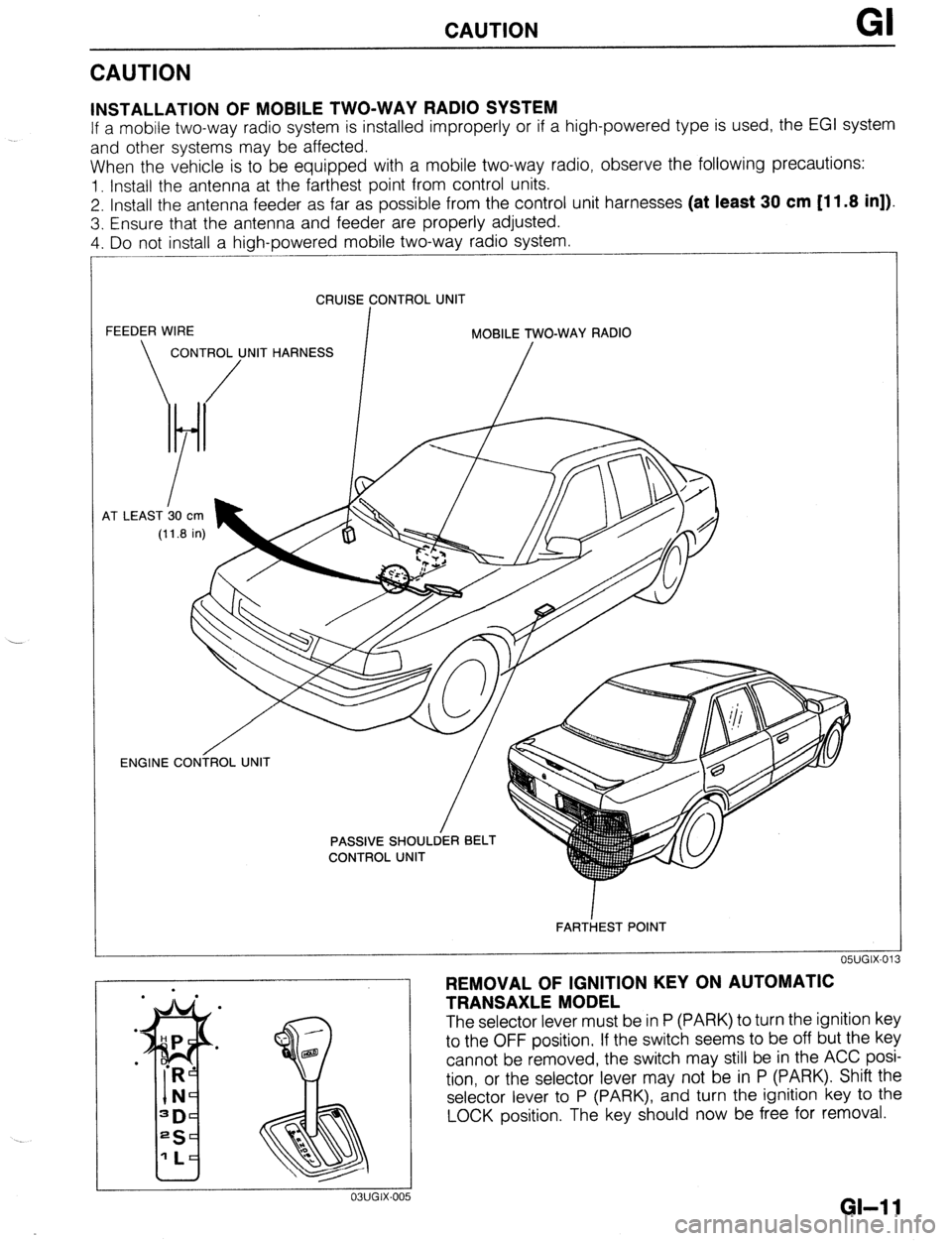
CAUTION GI
CAUTION
INSTALLATION OF MOBILE TWO-WAY RADIO SYSTEM
If a mobile two-way radio system is installed improperly or if a high-powered type is used, the EGI system
and other systems may be affected.
When the vehicle is to be equipped with a mobile two-way radio, observe the following precautions:
1. Install the antenna at the farthest point from control units.
2. Install the antenna feeder as far as possible from the control unit harnesses (at least 30 cm [11.8 in]).
3. Ensure that the antenna and feeder are properly adjusted.
4. Do not install a high-powered mobile two-way radio system.
CRUISE CONTROL UNIT
FEEDER WIRE
I MOBILE TWO-WAY RADIO
CONTROL UNIT HARNESS
/ /
4T LEAST b0
cm
(11.8 in)
OWGIX-013 ENGINE CONiROL UNIT
/
FARTiEST POINT
REMOVAL OF IGNITION KEY ON AUTOMATIC
TRANSAXLE MODEL
The selector lever must be in P (PARK) to turn the ignition key
to the OFF position. If the switch seems to be off but the key
cannot be removed, the switch may still be in the ACC posi-
tion, or the selector lever may not be in P (PARK). Shift the
selector lever to P (PARK), and turn the ignition key to the
LOCK position. The key should now be free for removal.
GI-1 1
Page 20 of 1164
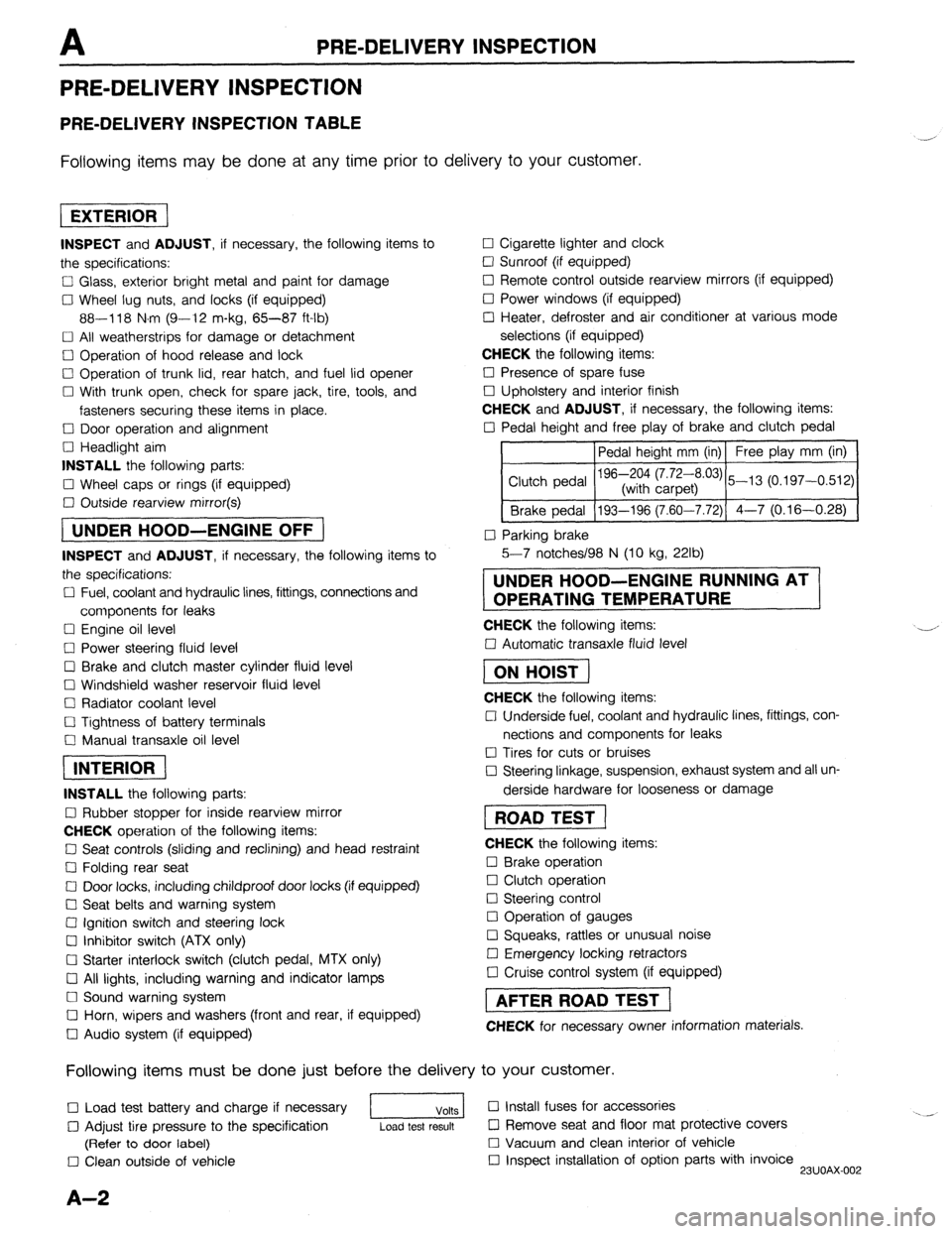
PRE-DELIVERY INSPECTION
PRE-DELIVERY INSPECTION
PRE-DELIVERY INSPECTION TABLE
Following items may be done at any time prior to delivery to your customer.
INSPECT and ADJUST, if necessary, the following items to
the specifications:
0 Glass, exterior bright metal and paint for damage
Cl Wheel lug nuts, and locks (if equipped)
88-118 N.m (9-12 m-kg, 65-87 ft-lb)
q All weatherstrips for damage or detachment
0 Operation of hood release and lock
0 Operation of trunk lid, rear hatch, and fuel lid opener
Cl With trunk open, check for spare jack, tire, tools, and
fasteners securing these items in place.
Cl Door operation and alignment
Cl Headlight aim
INSTALL the following parts:
Cl Wheel caps or rings (if equipped)
q Outside rearview mirror(s)
1 UNDER HOOD-ENGINE OFF )
INSPECT and ADJUST, if necessary, the following items to
the specifications:
0 Fuel, coolant and hydraulic lines, fittings, connections and
components for leaks
Cl Engine oil level
0 Power steering fluid level
0 Brake and clutch master cylinder fluid level
El Windshield washer reservoir fluid level
Cl Radiator coolant level
Cl Tightness of battery terminals
Cl Manual transaxle oil level
riizmiq
INSTALL the following parts:
Cl Rubber stopper for inside rearview mirror
CHECK operation of the following items:
0 Seat controls (sliding and reclining) and head restraint
Cl Folding rear seat
0 Door locks, including childproof door locks (if equipped)
Seat belts and warning system
Cl Ignition switch and steering lock
0 Inhibitor switch (ATX only)
U Starter interlock switch (clutch pedal, MTX only)
Cl All lights, including warning and indicator lamps
Cl Sound warning system
Cl Horn, wipers and washers (front and rear, if equipped)
0 Audio system (if equipped) 0 Cigarette lighter and clock
0 Sunroof (if equipped)
II Remote control outside rearview mirrors (if equipped)
Cl Power windows (if equipped)
q Heater, defroster and air conditioner at various mode
selections (if equipped)
CHECK the following items:
Cl Presence of spare fuse
0 Upholstery and interior finish
CHECK and ADJUST, if necessary, the following items:
0 Pedal height and free play of brake and clutch pedal
Pedal height mm (in) Free play mm (in)
0 Parking brake
5-7 notches/98 N (10 kg, 22lb)
UNDER HOOD-ENGINE RUNNING AT
OPERATING TEMPERATURE
CHECK the following items:
q Automatic transaxle fluid level
[I
CHECK the following items:
Cl Underside fuel, coolant and hydraulic lines, fittings, con-
nections and components for leaks
0 Tires for cuts or bruises
0 Steering linkage, suspension, exhaust system and all un-
derside hardware for looseness or damage
[I
CHECK the following items:
0 Brake operation
0 Clutch operation
Cl Steering control
Cl Operation of gauges
q Squeaks, rattles or unusual noise
Cl Emergency locking retractors
0 Cruise control system (if equipped)
1 AFTER ROAD TEST (
CHECK for necessary owner information materials.
Following items must be done just before the delivery to your customer.
q Load test battery and charge if necessary
1 Volts 1 0 Install fuses for accessories
i.. _
0 Adjust tire pressure to the specification
Load test result cl Remove seat and floor mat protective covers
(Refer to door label) 0 Vacuum and clean interior of vehicle
0 Clean outside of vehicle q Inspect installation of option parts with invoice
23UOAX-002
A-2
Page 21 of 1164
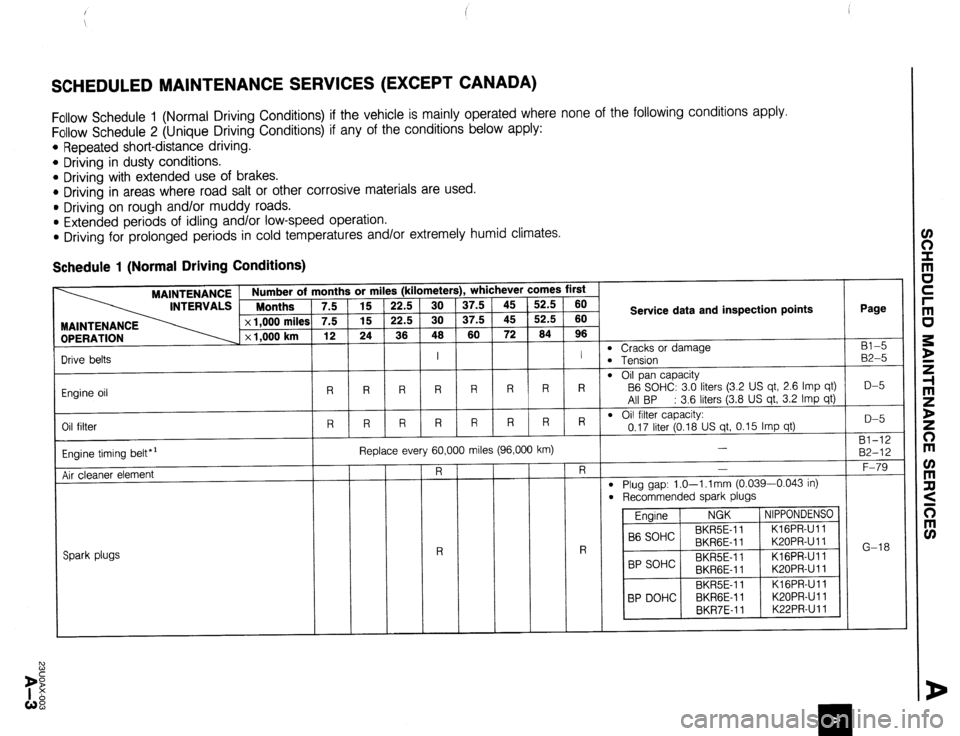
SCHEDULED MAINTENANCE SERVICES (EXCEPT CANADA)
Follow Schedule 1 (Normal Driving Conditions) if the vehicle is mainly operated where none of the following conditions apply.
Follow Schedule 2 (Unique Driving Conditions) if any of the conditions below apply:
l Repeated short-distance driving.
l Driving in dusty conditions.
* Driving with extended use of brakes.
* Driving in areas where road salt or other corrosive materials are used.
l Driving on rough and/or muddy roads.
l Extended periods of idling and/or low-speed operation.
l Driving for prolonged periods in cold temperatures and/or extremely humid climates.
Schedule 1 (Normal Driving Conditions)
Number of months or miles (kilometers), whichever comes first
Months 7.5 15 22.5 30 37.5 45 52.5 60
7.5 15 22.5 30 37.5 45 52.5 60
12 24 36 46 60 72 64 96 Service data and inspection points Page
Bl-5
B2-5
D-5
D-5
Bl-12
B2-12
F-79
G-18 MAINTENANCE
OPERATION
m Cracks or damage
B Tension
m Oil pan capacity
B6 SOHC: 3.0 liters (3.2 US qt, 2.6 Imp qt)
All BP : 3.6 liters (3.8 US qt, 3.2 Imp qt)
l Oil filter capacity:
0.17 liter (0.18 US qt, 0.15 Imp qt)
-
l Plug gap: 1.0-l .l mm (0.039-0.043 in)
l Recommended spark plugs
Engine NGK NIPPONDENSO
B6 SOHC BKR5E-11 KIGPR-Ull
BKRGE-11 K20PR-U 11
BP SOHC BKR5E-11 KlGPR-Ull
BKRGE-11 K20PR-U 11
BKR5E-11 KlGPR-Ull
BP DOHC BKRGE-11 K20PR-U 11
BKR7E-11 K22PR-Ull I I
R R R R R R R R
R R R R R R R R Drive belts
Engine oil
Oil filter
Engine timing belt*’
Air cleaner element Replace every 60,000 miles (96,000 km)
I
Spark plugs
Page 22 of 1164

7 Schedule 1 (Normal Driving Conditions) (Cont’d)
MAINTENANCE
INTERVALS 1 ::::“’ rths ’ 7.5
DPERATION x 1,000 miles
x 1,000 km 3r mi
15
15
24
1
Page
l- . whichever comes first s (kilometer!
37.5
37.5
60 52.5
52.5
64 60
60
96
I
l-7
Service data and inspection points
l Hoses for cracks or wear l Coolant level E-5
Zooling system
Engine coolant
Fuel filter
‘die speed
Fuel lines
Brake lines, hoses and connections
l Coolant capacity:
5.0 liters (5.3 US qt, 4.4 Imp qt) . . . . . . . . . . MTX
6.0 liters (6.3 US qt, 5.3 Imp qt) . . . . . . . . . . ATX
I E-6 -
F-l 24
l ATX: P range, MTX: Neutral
700-800 rpm (with parking brake applied)
l Fittings, connections, and components for F-80
F-120
-
H-6
P-28
P-29
P-20
P-25
P-18
P-25
---
N-27
N-8
-
M-21
-
F-136
u-35
u-39 leaks
0 Proper attachment and connections
l Operation l Pedal height (with carpet):
196-204mm (7.72-8.03 in)
l Free play:
5--13mm 10.197-0.512 in) Clutch pedal
l Wheel cylinder operation and leakage
l Lining for wear or damage l Lining thickness:
Minimum . . . . . 1 .Omm (0.04 in)
l Drum inner diameter
Maximum..... 201mm (7.91 in) Drum brake
l Caliper operation l Disc plate thickness:
Minimum.... Front 20mm (0.79 in)
Rear 7.0mm (0.28 in)
l Pad thickness:
Minimum.... Front 2.0mm (0.08 in)
Rear l.Omm (0.04 in)
l Operation and looseness l Fluid leakage or oozing l Free play.... O-30mm (O-l .18 in)
l Damage, looseness, and grease leakage
l Cracking and damage
l Retighten all loose nuts and bolts I
1
Disc brake
I
---l-T
Steering operation and linkage
Front suspension ball joints
Drive shaft dust boots
Bolts and nuts on chassis and body
Exhaust system heat shield
Air conditioner system (if equipped) Refrigerant
Compressor am01 anni I
l Insulation clearance
- ,.
Inspect rerrlgerar
Inspect operation annually -
Page 23 of 1164
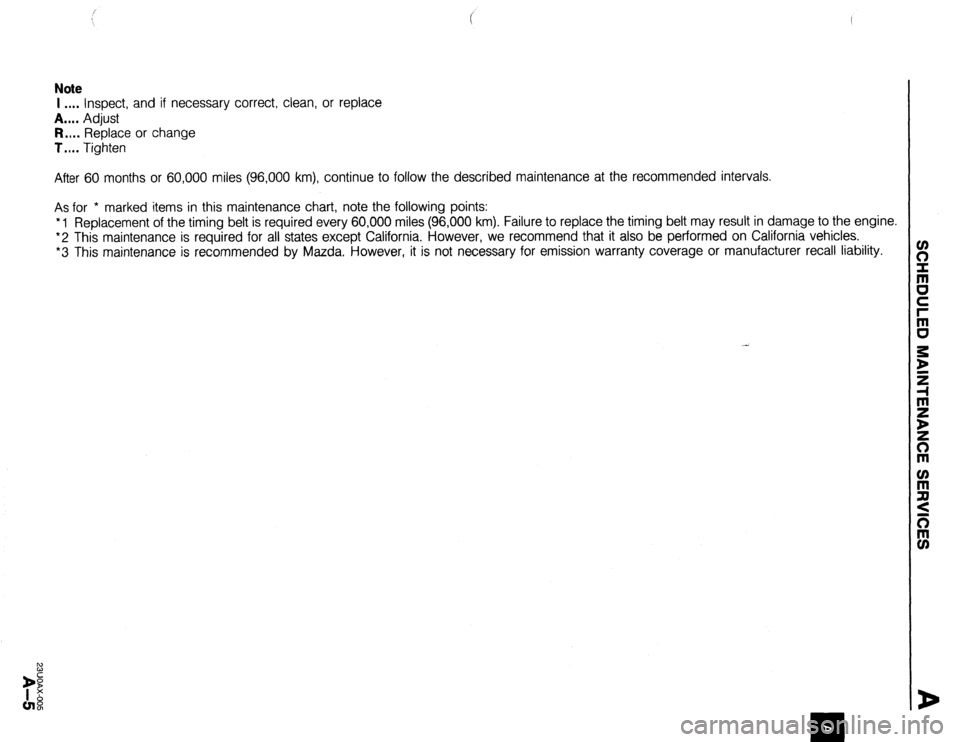
Note
I .*.* Inspect, and if necessary correct, clean, or replace
A.... Adjust
R.... Replace or change
T.... Tighten
After 60 months or 60,000 miles (96,000 km), continue to follow the described maintenance at the recommended intervals.
As for * marked items in this maintenance chart, note the following points:
* 1 Replacement of the timing belt is required every 60,000 miles (96,000 km). Failure to replace the timing belt may result in damage to the engine.
*2 This maintenance is required for all states except California. However, we recommend that it also be performed on California vehicles.
*3 This maintenance is recommended by Mazda. However, it is not necessary for emission warranty coverage or manufacturer recall liability.